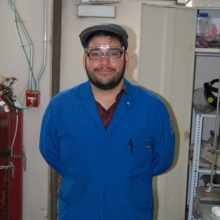
University:
University of Texas at El Paso
Major:
Metallurgical & Materials Engineering
Mentor(s):
Colin A. Stewart
Faculty Sponsor(s):
Carlos G. Levi
Faculty Sponsor's Department(s):
Materials
Mechanical Engineering
Project Title:
Oxidation Study of Four Novel Cobalt Based Superalloys
Project Description:
To further the advancement of high efficiency turbine design for energy and aeronautic applications, employed materials must withstand greater temperatures. Recently discovered specialized alloying in cobalt superalloys, specifically the Co-Al-W ternary system, have the ability to achieve cuboidal L12 ordered precipitates, and an increase in the max solidus and liquidus temperatures. These changes may lead to the possibility of higher operating temperatures and increases in efficiency, if the issue of oxidation can be addressed for turbines utilizing these components. In this study we will examine four novel Cobalt alloys that all contain additions of Nickel, Aluminum, Tungsten, Chromium, Tantalum, Boron, and Carbon with various alloying additions of Lanthanum, Yttrium, and Molybdenum with end intent of forming a continuous α-alumina scale. The alloys will be oxidized at 1100˚C in two environments: low P_(O_2 ) and air. The oxide scale has been characterized with Grazing Incidence X-Ray Diffraction (GIXRD), Raman Spectroscopy and Scanning Electron Microscopy (SEM) in order to observe if it forms a passivating layer of α-alumina, characterize any other oxides that may degrade the material in service. The alloy system with Lanthanum has shown in both Low P_(O_2 ) and air oxidations the lowest mass change per unit surface area and has shown evidence of α-alumina formation in both environments. The system s containing Yttrium and Molybdenum shows evidence of α-alumina formation in low P_(O_2 ) but not in air.
